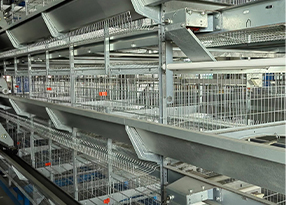Effective Strategies for Managing a Sustainable Poultry Farm with Cage Systems for Optimal Production
Aug . 01, 2024 02:40 Back to list
Effective Strategies for Managing a Sustainable Poultry Farm with Cage Systems for Optimal Production
The Benefits and Challenges of Poultry Farm Cages
Poultry farming, a vital sector in global agriculture, has evolved over the years to accommodate the growing demand for eggs and chicken meat. One of the prominent methods used to raise poultry is through cages, specifically designed housing systems that aim to maximize efficiency and productivity. While the use of cages offers several advantages, it also poses significant ethical and welfare challenges that cannot be overlooked.
Advantages of Poultry Farm Cages
One of the primary benefits of using cages for poultry farming is enhanced space utilization. Caged systems allow farmers to keep a larger number of birds in a confined space, which can lead to higher production levels. This system is particularly prevalent in egg-laying operations, where hens are often housed in battery cages. These cages can be stacked vertically, optimizing the use of limited land space and increasing the overall yield of the farm.
In addition to spatial efficiency, caged environments provide a controlled setting that can lead to improved biosecurity. The confinement of birds reduces their exposure to diseases and predators, which can be more prevalent in free-range systems. This controlled environment allows farmers to implement strict hygiene measures, ultimately leading to lower mortality rates and healthier flocks.
Another significant advantage is the ease of management associated with caged systems. With chickens housed in cages, tasks such as feeding, cleaning, and collection of eggs become more straightforward. Automated systems can be employed to streamline these processes, reducing labor costs and allowing farmers to focus on other aspects of their operations. The predictability of production cycles in caged systems can also lead to more stable income for poultry farmers, as they can better manage resources and predict output.
Ethical and Welfare Concerns
poultry farm cage

Despite these advantages, the use of cages in poultry farming has drawn considerable criticism. Animal welfare advocates argue that caged systems, particularly battery cages, severely restrict the natural behaviors of birds. In such confinement, hens are often unable to exhibit behaviors such as nesting, foraging, and dust bathing, which are essential for their physical and psychological well-being. The resulting stress from the lack of movement and social interaction can lead to health problems, including feather pecking and cannibalism.
Several countries and regions have begun to take action against the use of battery cages, pushing for more humane alternatives. This shift in consumer attitude has led to a growing demand for cage-free eggs, which has prompted many farmers to reconsider their production methods. However, transitioning to cage-free systems often comes with increased costs and logistical challenges, potentially impacting the economic viability of farms that previously relied on caged systems.
The Way Forward
The debate concerning poultry farm cages is complex and multifaceted. While the benefits of increased efficiency and management simplicity cannot be dismissed, the ethical considerations regarding the welfare of the animals must be prioritized. For the industry to move forward, an emphasis on developing more humane farming practices is necessary.
Farmers can explore alternatives such as enriched cages, which provide the birds with more space and amenities, allowing for a better quality of life while still benefiting from the efficiencies of caged systems. Additionally, investing in technology to improve monitoring of bird health and well-being could help bridge the gap between productivity and welfare.
Ultimately, the future of poultry farming will depend on the industry’s ability to balance the demands of consumers for ethical treatment of animals with the economic realities of feeding a growing population. Transitioning towards more sustainable practices, including the modernization of poultry housing systems, will be critical in achieving this balance. As consumers become more aware and concerned about animal welfare, poultry farmers must adapt to these changing expectations while also maintaining productivity and profitability.
-
Hot Sale 24 & 18 Door Rabbit Cages - Premium Breeding Solutions
NewsJul.25,2025
-
Automatic Feeding Line System Pan Feeder Nipple Drinker - Anping County Yize Metal Products Co., Ltd.
NewsJul.21,2025
-
Automatic Feeding Line System Pan Feeder Nipple Drinker - Anping County Yize Metal Products Co., Ltd.
NewsJul.21,2025
-
Automatic Feeding Line System - Anping Yize | Precision & Nipple
NewsJul.21,2025
-
Automatic Feeding Line System - Anping Yize | Precision & Nipple
NewsJul.21,2025
-
Automatic Feeding Line System-Anping County Yize Metal Products Co., Ltd.|Efficient Feed Distribution&Customized Animal Farming Solutions
NewsJul.21,2025






